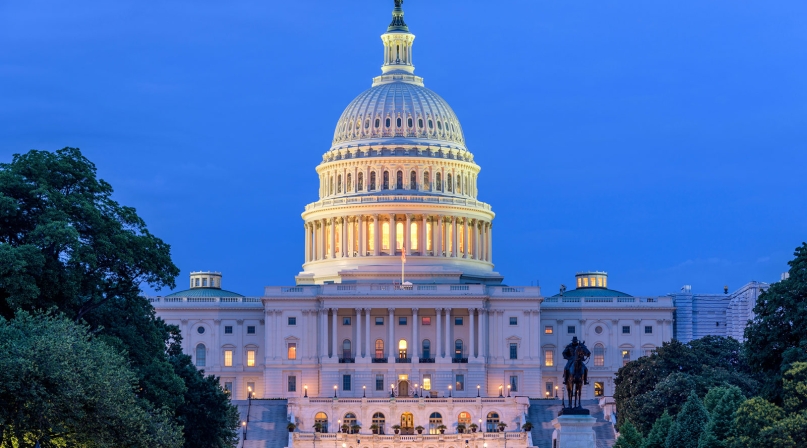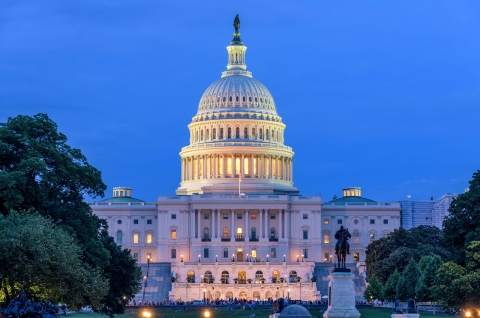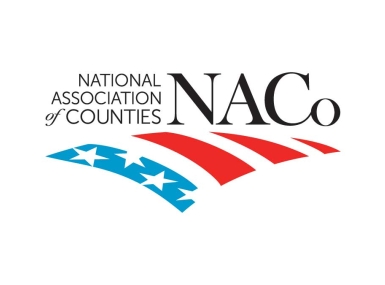Key health, human services and workforce programs boosted under U.S. House FY 2021 spending proposal
Upcoming Events
Related News

Key Takeaways
On July 13, the U.S. Appropriations Committee approved its FY 2021 spending bill for the U.S. Departments of Labor (DOL), Health and Human Services (HHS) and Education (ED) and Related Agencies. The legislation outlines federal spending priorities for the next fiscal year for programs falling under the jurisdiction of these federal agencies and represents the largest non-defense funding measure of the 12 annual spending bills considered by Congress.
For FY 2021, the bill allocates a combined $196.5 billion in discretionary funding for Labor-HHS programs, an increase of $2.4 billion above the FY 2020 enacted levels and $20.8 billion above President Trump’s FY 2021 budget request. As passed, the measure boosts or maintains funding levels for many federal health, human services and workforce programs counties engage to ensure the well-being of our residents. Unique to the current appropriations cycle, the FY 2021 proposal follows major increases to FY 2020 funding for key health and human services programs set forth under recent COVID-19 relief bills, including the Families First Coronavirus Response Act (FFCRA; P.L. 116-127) and the CARES Act (P.L. 116-136). The programs receiving extra funding – from Head Start to the Public Health and Social Services Emergency Fund – took on special importance for states and localities operating on the frontlines of the COVID-19 pandemic.
Given the importance of these programs for counties, highlighted below are topline appropriations figures for the agencies and programs outlined under the FY 2021 Labor-HHS proposal.
Funding boosted for county health and human services priorities
For FY 2021, the U.S. House bill would allot $96.4 billion for the U.S. Department of Health and Human Services (HHS), a $1.5 billion increase above the FY 2020 enacted level. The largest portion of this funding would be invested in the National Institutes of Health (NIH), which would receive $47 billion, and the Centers for Disease Control and Prevention (CDC), which would be funded at $8 billion for FY 2021. Funding for NIH and CDC would support research, prevention and education activities, with an emphasis on Alzheimer’s disease ($2.9 billion), HIV/AIDS research ($3.1 billion) and continued investments in opioids research.
Additionally, the bill includes $24.4 billion in emergency spending for state and local public health labs and $9 billion in supplemental appropriations for CDC to improve the nation’s preparedness for public health emergencies. The funding includes $56 million for public health workforce initiatives, an increase of $5 million from FY 2020, and $2 billion for public health emergency preparedness cooperative agreements to increase state and local public health emergency response capabilities. Strengthening the local public health workforce is a key priority for counties as we operate on the frontlines of health emergencies such as the pandemic.
In addition to funding increases for NIH and CDC programs, the U.S. House legislation would also boost funding for the Substance Abuse and Mental Health Services Administration (SAMHSA), which plans and operates community-based services for people with mental illnesses and substance use disorders. For FY 2021, SAMHSA would receive $6 billion, a $96 million increase above the FY 2020 enacted level, with modest increases for substance use disorder prevention activities and treatment programs, which would receive $209 million and $3.8 billion in FY 2021, respectively. Funding would also be increased by $157 million for the Health Resources and Services Administration (HRSA) in FY 2021 to $7.2 billion, and cover programs including the Maternal and Child Health Block Grant and telehealth activities within the agency’s Rural Health Programs.
The FY 2021 measure also includes funding increases for several federal human services programs administered through HHS. The legislation allocates $5.9 billion for the Child Care and Development Block Grant (CCDBG) and $10.8 billion for Head Start, a combined increase of $250 million for FY 2021. Both programs provide counties with critical resources to support early childhood development and education. The bill would also fund the Community Services Block Grant (CSBG) at $750 million for FY 2021, an increase of $10 million above the FY 2020 enacted level. The block grant enables counties to design and implement anti-poverty programs tailored to local needs. The Child Abuse Prevention and Treatment Act (CAPTA) program, which provides grants to support child abuse prevention, assessment, investigation, prosecution and treatment activities, would receive $193 million, an increase of $12.5 million. Counties fully or partially administer the child welfare system in 11 states. The bill also provides $3.8 billion for the Low-Income Home Energy Assistance Program (LIHEAP), a $25 million increase above FY 2020. Counties fully or partially administer LIHEAP, which helps eligible low-income families with the costs of heating and cooling, weatherization and energy crises, in 13 states.
The bill funds the Administration for Community Living (ACL) at $2.3 billion, a $56 million increase above the FY 2020 enacted level. ACL administers programs that support counties operating or partnering with local Area Agencies on Aging to keep elderly residents living safely and independently in the community, including the Senior Nutrition Program, which at $957 million would receive a $20 million increase over FY 2020.
Notably, the subcommittee’s bill includes new health policy provisions for FY 2021, including reporting requirements for the Strategic National Stockpile as a critical piece of the COVID-19 response, as well as protections for non-emergency medical transportation under the Medicaid program. The bill also directs the Centers for Medicare and Medicaid Services (CMS) to transfer at least $100 million of carryover Affordable Care Act (ACA) user fees to support program outreach and enrollment during the open enrollment period.
On the human services side, the legislation outlines new oversight and counseling provisions for facilities responsible for the care of unaccompanied child arrivals to the United States. It also prohibits funds from being awarded to a foster care organization that does not comply with nondiscrimination regulations related to age, disability, sex, race, color, national origin, religion, gender identity or sexual orientation.
Workforce and education program funding increased in FY 2021, with key county priorities included
Under the FY 2021 legislation, the U.S. Department of Labor (DOL) would receive $12.7 billion in discretionary appropriations, $254 million above the FY 2020 enacted level. Of this total, the Employment Training Administration (ETA) would receive the bulk of the funding at $10.2 billion, a $187 million increase above the prior year.
ETA administers workforce programs important to counties, including the Workforce Innovation and Opportunity Act (WIOA), which would receive $2.9 billion in funding for FY 2021, a $50 million increase above FY 2020. Within the $2.9 billion allocated to WIOA, Adult programs would receive $864.6 million; Youth activities would receive $925 million and approximately $1.1 billion would support Dislocated Worker programs. Counties play a central role in administering and delivering WIOA’s workforce and education programs to local residents.
Key job training services for residents would also receive funding increases under the U.S. House legislation. The bill allocates $101 million for the YouthBuild program, an increase of $6 million above the FY 2020 enacted level. Registered Apprenticeships would also receive an increase to $185 million in FY 2021, $10 million above prior year funding, and the Job Corps program would receive $1.76 billion, $12 million above the FY 2020 enacted level.
Important to counties, the legislation allocates $50 million in FY 2021 funding for community colleges and eligible four-year partner programs through the Strengthening Community College Training Grants (SCCTG). Funding would be aimed at meeting local and regional labor market demand by providing skills training to employees in in-demand industries.
The Labor-HHS bill also provides a total of $73.5 billion in discretionary appropriations for the U.S. Department of Education (ED), an increase of $716 million above the FY 2020 enacted level and $6.9 billion above the president’s budget request. The measure provides $16.6 billion—a $254 million increase above FY 2020—for Title I Grants to Local Educational Agencies, which provide resources to high-poverty school districts. It would also provide $14.1 billion for Special Education programs, including the Individuals with Disabilities in Education Act (IDEA) and the Special Olympics, an increase of $208 million above the FY 2020 enacted level. The bill also includes $2 billion for Career, Technical and Adult Education, an increase of $25 million above the FY 2020.
Additionally, the measure includes education-related policy provisions including the elimination of statutory language that currently prohibits federal dollars from supporting school transportation for the purpose of racial integration. It also includes new language allowing incarcerated individuals to be eligible for Pell Grants, federal need-based awards that help eligible low-income individuals pay for college.
Timeline for approval of FY 2021 measure unclear as Congress eyes coming deadlines and other legislative business
Following its approval by the U.S. House Appropriations Committee, the bill now goes to the full chamber for consideration. However, the Labor-HHS and other U.S. House-passed appropriations bills could face opposition in the GOP-controlled U.S. Senate. Further complicating the path forward is the September 30, 2020 deadline, after which FY 2020 funds will expire. Congress could also still move on a fifth COVID-19 relief package in the coming weeks, with unemployment benefits slated to expire on July 31.
NACo will continue to engage with congressional appropriators and key committees of jurisdiction to ensure counties have the resources to support the health, well-being and economic opportunity of our residents.
For more resources on FY 2020 and FY 2021 appropriations, please see the following links:
- Analysis of the President's FY 2021 Budget Request (NACo legislative analysis)
- Highlights for Counties in the FY 2020 Omnibus (NACo legislative analysis)
- U.S. House Appropriations Committee Statement on FY 2021 Labor-HHS Funding (U.S. House press release)

Attachments
Related News

County Countdown – Dec. 15, 2025
Every other week, NACo's County Countdown reviews top federal policy advocacy items with an eye towards counties and the intergovernmental partnership.

County Countdown – Dec. 1, 2025
Every other week, NACo's County Countdown reviews top federal policy advocacy items with an eye towards counties and the intergovernmental partnership.

Counties Celebrate Key Permitting Inclusions in SPEED Act
NACo issued the following statement in response to the passage of the Standardizing Permitting and Expediting Economic Development (SPEED) Act (H.R. 4776), which advanced out of the U.S. House Committee on Natural Resources on November 20.